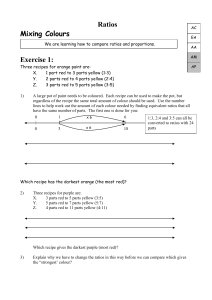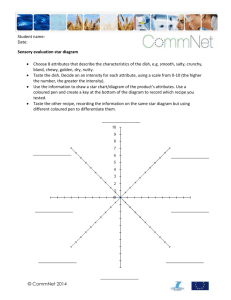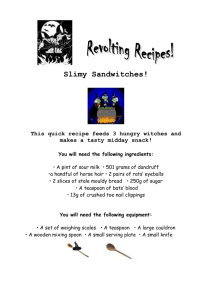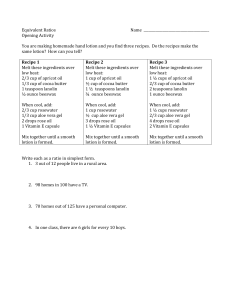Keeping Things In Proportion - Empower - EMPower
advertisement
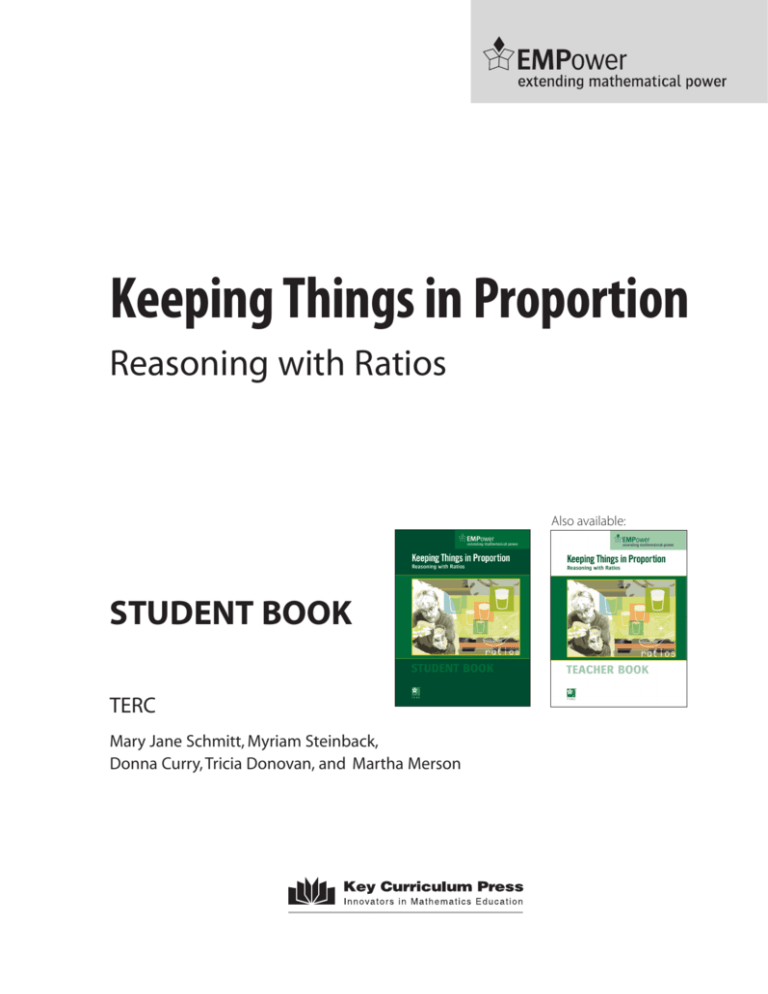
Keeping Things in Proportion Reasoning with Ratios Also available: STUDENT BOOK TERC Mary Jane Schmitt, Myriam Steinback, Donna Curry, Tricia Donovan, and Martha Merson LESSON 3 Tasty Ratios What do ratios have to do with taste? You can adjust a recipe to make a larger or smaller amount of food than is called for by the recipe. When you change the amounts of ingredients in a recipe, it is important that you keep the ratios the same. If not, you may find that what you have created does not taste good or have the right texture. In this lesson, you will use your senses (taste and sight) to guess the ratios of ingredients in orange juice mixtures. You will also use diagrams and the property of equal fractions to show how the ingredients are (or are not) in proportion. EMPower™ Lesson 3: Tasty Ratios 35 Activity 1: Orange Juice Taste Test Here is the label from the can used to make the orange juice. Describe how each of the orange juice mixtures tastes and looks. What do you imagine the ratio of water to frozen concentrate is in each mixture? Mixture A 1a. Describe the taste. b. Describe the look. c. What do you think the ratio of water to concentrate might be? Mixture B 2a. Describe the taste. b. Describe the look. c. What do you think the ratio of water to concentrate might be? Mixture C 3a. Describe the taste. b. Describe the look. c. What do think the ratio of water to concentrate might be? 36 Keeping Things in Proportion: Reasoning with Ratios EMPower™ Activity 2: “Doctoring” the Orange Juice Look at the recipes that were used to make the three orange juice mixtures. For each mixture, write the actual ratio of water to frozen concentrate. Now that you know the actual ingredients, how would you change, or “doctor,” Mixture B and Mixture C to taste like Mixture A without throwing any away? Mixture Actual Ratio of Water to Concentrate How I Would “Doctor” the Mixture So It Tastes Like Mixture A A B C EMPower™ Lesson 3: Tasty Ratios 37 Practice: How Does It Taste? Look at the following proportions of ingredients in recipes. Place a check mark beside the description of how the adjusted recipe might turn out based on its new ratio. 1. The Original Recipe The Adjusted Version 2 c. rice to 1 tsp. salt 4 c. rice to 4 tsp. salt Too salty? ____ Just right? ____ 2. The Original Recipe The Adjusted Version 18 c. bread cubes to 3 eggs Too dry? _____ Too watery? _____ The Adjusted Version c. vinegar to 2 c. oil Keeping Things in Proportion: Reasoning with Ratios 5 c. flour to 3 c. water Just right? _____ 5. The Original Recipe 38 Too sour? _____ The Adjusted Version 2 c. flour to 1 21 c. water Too oily? _____ 6 T. lime juice to 6 T. sugar Just right? _____ 4. The Original Recipe 3 4 Too wet? _____ The Adjusted Version 2 T. lime juice to 3 T. sugar Too dry? _____ 6 c. bread cubes to 1 egg Just right? _____ 3. The Original Recipe Too sweet? _____ Not salty enough? ____ 1 21 c. vinegar to 3 21 c. oil Just right? _____ Too vinegary? _____ EMPower™ Practice: Lemonade for the Party You have invited 15 people to a party. 1a. How many cans of water are needed for each can of concentrate to make lemonade? b. If you plan to serve each person 8 fl. oz. (1 cup), how many servings does one can make? c. What is the ratio of water to frozen lemonade concentrate? _________ water to _________ lemonade concentrate 2a. How many cans of frozen concentrate would you need to buy for the party? b. How much water would you need to add in all? c. How much lemonade would you have? 3. If you were adding ice cubes that would melt over time, what adjustments would you make to the recipe? EMPower™ Lesson 3: Tasty Ratios 39 Practice: Building a Set of Equal Ratios Create a set of ratios that are equal to the first one. Example: 1 5 10 = = 3 15 30 40 = 50 100 = 300 150 1. 2 = 5 = = = 2. 1 = 4 = = = 3. 3 = 4 = = = 4. 4 = 5 = = = Keeping Things in Proportion: Reasoning with Ratios 60 150 200 90 120 EMPower™ Practice: Popcorn Party Mix The popcorn recipe below makes about 2 21 quarts of party mix. How much of each ingredient would be needed for a triple batch? 1. Complete the following chart and then look at what happens to each of the numbers when you triple the amount. Original Recipe Triple the Recipe Show How You Did It 2 qt. popcorn 1 c. pretzels 1 1 2 c. cheese curls 3 4 c. salted peanuts 1 4 c. butter 1 T. Worcestershire sauce 1 2 tsp. garlic salt 2. If the original recipe makes about 2 21 quarts of party mix, how many quarts would there be if you tripled the recipe? Original Recipe Triple the Recipe Show How You Did It 1 2 2 qt. popcorn 3. How does the amount of butter in the new recipe compare to the total amount of party mix in the new recipe? Show that the ratio is the same as in the original recipe. EMPower™ Lesson 3: Tasty Ratios 41 Practice: Dressing It Up Below are the basic ingredients for creamy garlic dressing. 1 c. mayonnaise 3 T. milk 2 T. cider vinegar 1 garlic clove 1a. Triple the recipe. _____ c. mayonnaise _____ T. milk _____ T. cider vinegar _____ garlic cloves b. What is the ratio of mayonnaise to milk in the original recipe? c. What is the ratio of mayonnaise to milk in the new recipe? 2a. Quadruple the original recipe. _____ c. mayonnaise _____ T. milk _____ T. cider vinegar _____ garlic cloves b. What is the ratio of milk to vinegar in the original recipe? c. What is the ratio of milk to vinegar in the new recipe? 42 Keeping Things in Proportion: Reasoning with Ratios EMPower™ Practice: Doctor This Following are three stories about individuals who have problems with their recipes. Think about how you can help them to readjust their ingredients so that everything is still in balance. 1. A recipe for a cake calls for half a stick of butter and two eggs. Ingram was distracted and beat in 1 stick of butter and three eggs. a. What should he do now to fix the proportions of the ingredients? b. How will he have to adjust the remaining ingredients? c. How many cakes will he end up making? 2. A brownie recipe calls for 2 cups of sugar and 3 cups of flour. Rachel discovers that she only has 1 cup of sugar. a. How could she adjust the recipe to keep the ingredients in balance? b. How will she have to adjust the remaining ingredients? 3. A recipe that makes 5 dozen cookies calls for 3 eggs and 6 cups of flour. Sue only has 2 eggs. a. How could she adjust the recipe to keep the ingredients in proportion? b. What will she have to do with the remaining ingredients? c. About how many cookies will she end up making? EMPower™ Lesson 3: Tasty Ratios 43 Extension: Reasoning with Ratios You can make punch with strawberry syrup and water. 1. Pitcher A contains punch that has a stronger strawberry taste than the punch in Pitcher B. If one cup of strawberry syrup is added to Pitcher A and one cup of water is added to pitcher B, which pitcher will contain the punch with the stronger strawberry taste? Explain your reasoning. A B 2. The punch in both Pitchers A and B has the same taste. If one cup of strawberry syrup is added to both pitchers, which pitcher will contain the punch with the stronger strawberry taste? Explain your reasoning. A 44 Keeping Things in Proportion: Reasoning with Ratios B EMPower™ 3. Pitcher A contains punch with a stronger strawberry taste. If one cup of strawberry syrup is added to both pitchers, which pitcher will contain the punch with the stronger strawberry taste? Explain your reasoning. A B 4. Pitcher B contains punch with the stronger strawberry taste. If one cup of syrup is added to Pitcher A and one cup of water is added to Pitcher B, which pitcher will contain the punch with the stronger strawberry taste? Explain your reasoning. A EMPower™ B Lesson 3: Tasty Ratios 45 Test Practice 1. A recipe calls for 2 cups of sugar to 21 cup of lime juice. How much lime juice should be added if the new recipe uses 6 cups of sugar? 4. A recipe calls for 3 cups of water to serve 8 people. If Shaina is planning to serve 4 people, how many cups of water should she use? (1) 1 cup (1) 1 cups (2) 1 21 cups (3) 2 cups (2) 1 1 cups (4) 2 21 cups (5) 3 cups (4) 7 cups 2. A recipe calls for 21 cup of vinegar to 43 cup of oil. How much vinegar should be added if the new recipe uses 1 21 cups of oil? (1) 41 cup (2) 21 cup (3) 43 cup (4) 1 cup (5) 1 21 cups 3. A recipe calls for 3 potatoes to serve 4 people. If Jacques is planning to serve a crowd of 20 people, how many potatoes should he use? 2 (3) 2 cups (5) 12 cups 5. A party punch calls for 6 oz. of concentrate to 5 cups of water. If you only have 3 oz. of concentrate, how much water should you use? (1) 2 cups (2) 2 21 cups (3) 3 cups (4) 3 21 cups (5) 4 cups 6. A muffin recipe calls for 3 tsp. of baking powder to 31 cup sugar. How many cups of sugar would be needed to triple the recipe? (1) 7 potatoes (2) 12 potatoes (3) 15 potatoes (4) 60 potatoes (5) 80 potatoes 46 Keeping Things in Proportion: Reasoning with Ratios EMPower™ Keeping Things in Proportion Reasoning with Ratios Also available: TEACHER BOOK TERC Mary Jane Schmitt, Myriam Steinback, Donna Curry, Tricia Donovan, and Martha Merson FACILITATING LESSON 3 Tasty Ratios What do ratios have to do with taste? Synopsis This lesson gives students an opportunity to play with ratios using their sense of taste. The focus for students is twofold: to maintain the ratio of the ingredients when making a new recipe and to adjust ingredients in order to fix a failed recipe. 1. The class discusses the need for using correct proportions when cooking. 2. In small groups, students taste three orange juice mixtures and speculate about the ratio of water to concentrate. They compare their conclusions before checking them against the recipes actually used. 3. Students consider how to fix the failed mixtures so the ingredients are in the right proportion to one another. 4. Students summarize ways to ensure that the ratio of two ingredients is maintained. Objectives • Use ratios to describe taste and visual comparisons • Determine how to adjust ingredients so that the proportions are correct EMPower™ Facilitating Lesson 3: Tasty Ratios 37 Materials/Prep • Markers • Newsprint • Post-it Notes • Small paper cups (three per student) for sampling orange juice • Three spoons for stirring mixtures Make copies of Orange Juice Recipe (Blackline Master 4) or Alternate Orange Juice Recipe (Blackline Master 5), depending on which you will use. Prepare three posters like the one below, one for each orange juice mixture (A, B, and C) in Activity 1: Mixture A Describe the taste: Describe the look: Guess the ratio of water to frozen concentrate: Orange Juice Recipe for a class of more than five students • 1 gallon of water • 2 (12 fl. oz.) cans of frozen orange juice concentrate that calls for three cans of water to one can of concentrate • 3 empty containers (at least one-half gallon capacity each) to hold the three orange juice mixtures Prepare Mixture A, where the proportions are correct (3 parts water:1 part concentrate). Add three cans of water to one can of orange juice concentrate and stir. This will yield a normal mixture. Step 1 38 Keeping Things in Proportion: Reasoning with Ratios Step 2 A B 3:1 1:1 EMPower™ Prepare Mixture B with one-third the recommended amount of water (1 part water:1 part concentrate). Add one can of water to one can of orange juice concentrate and stir. This will yield a thick mixture. Step 1 Step 2 A B 3:1 1:1 Prepare Mixture C, in which there is much more water than there should be (7 parts water:1 part concentrate). Pour 16 fl. oz. (2 cups—not cans) of Mixture A into a container and add 16 fl. oz. of water. This will yield a very weak mixture. Step 3 16 oz. Water Water Water 16 oz. A C Water Water A A A A A A A A 7:1 Alternate Recipe (for a class of five or fewer students) • 1 (12 fl. oz.) can of frozen orange juice concentrate that calls for three cans of water to one can of concentrate • 1/2 gallon of water • 3 empty containers (at least one-half gallon capacity each) to hold the three orange juice mixtures Divide the concentrate into thirds. Prepare Mixture A, where the proportions are correct (3 parts water:1 part concentrate). Add one can of water to one-third of a can of orange juice concentrate and stir. This will yield a normal mixture. EMPower™ Facilitating Lesson 3: Tasty Ratios 39 Prepare Mixture B with one-third the recommended amount of water (1 part water:1 part concentrate). Add one-third of a can of water to one-third of a can of orange juice concentrate and stir. This will yield a thick mixture. Prepare Mixture C, in which there is much more water than there should be (7 parts water:1 part concentrate). Add 2 1/3 cans of water to 1/3 of a can of orange juice concentrate. This will yield a very weak mixture. Heads Up! Prepare orange juice mixtures before the class begins. Be sure to use the ratios described in the directions for preparation above. Opening Discussion Begin by asking students to consider the role of proportion in cooking. Refer students to the recipe for pancakes on p. 35 of the Student Book. Once they have examined the recipe, ask: If only one of the ingredient amounts in this pancake recipe were changed, what would the pancakes taste like? For example, what if the amount of flour were doubled? What if the amount of baking powder were cut in half? What if the sugar were tripled? Listen to responses. Do students have a sense of the effect of changing one ingredient? Ask students to consider their own personal experiences with recipes. Have you ever made a mistake following a recipe? What happened? How did it taste? Why? After students share experiences, say: Today you will use your senses of taste and sight to make judgments about whether I used the correct proportions when making mixtures of orange juice. Later you will figure out how to fix any mistakes I might have made. Activity 1: Orange Juice Taste Test For this activity, students will examine and taste a little of each of the three containers of orange juice that you prepared. Each container will be a different concentration, stirred and well labeled (A, B, or C). Set up a station as shown in the picture (or pass around cups labeled A, B, and C). Also have either the empty can or the label available for students to examine. 40 Keeping Things in Proportion: Reasoning with Ratios EMPower™ Ask everyone to pour a little of each mixture into three cups, labeling their cups “A,” “B,” and “C.” Before taste-testing each mixture, ask students to look at the mixtures and predict what they think the ratio of water to concentrate is for each. Then ask students to taste a little of each to adjust their predicted ratio and then to write their predictions down on p. 36 in the Student Book. Also ask students to write each of their predictions on a separate Post-it Note and place their answers on the class posters labeled “Mixture A,” “Mixture B,” and “Mixture C.” After everyone has written their responses, hand out your actual recipe (either Blackline Master 4 or 5, depending on which recipe you used). Ask: What do you think of the guesses? Which guess was the closest in each case? Give students plenty of time to figure this out alone and in pairs, and then ask for responses. Figuring out Mixture C is a real challenge and should elicit discussion and a lot of drawing. There are many ways to think about this. Some people might think about Mixture C this way: 16 fl. oz. of Mixture A has 3 parts water and 1 part concentrate, but Mixture C has 4 more parts of water. That makes 7 parts water and 1 part concentrate (14 fl. oz. of water to 2 fl. oz. of concentrate). So Mixture C is a 7:1 ratio. Other students may interpret the Mixture C recipe as follows: 16 fl. oz. of Mixture A has 12 fl. oz. of water and 4 fl. oz. of concentrate (3 to 1). If you add 16 more fl. oz. of water, you get a mixture with 28 fl. oz. of water and 4 fl. oz. of concentrate. This is a 7 to 1 ratio of water to concentrate. EMPower™ Facilitating Lesson 3: Tasty Ratios 41 A diagram might look like this: Mixture A (3:1) Mixture C (7:1) 28 fl. oz. Water 12 fl. oz. Water 4 fl. oz. Concentrate 4 fl. oz. Concentrate Activity 2: “Doctoring” the Orange Juice Encourage students to work in pairs or triads to figure out how to create mixtures that are in balance from the failed Mixtures B and C. Ask: How would you fix Mixture B without throwing any away? How would you fix Mixture C without throwing any away? Encourage picture drawing. For Mixture B, the “fix” is fairly easy if you add 2 more cans of water. For Mixture C, you would have to add some more concentrate and possibly a little water. But how much? Some people might think of it this way: If you have 28 fl. oz. of water and 4 fl. oz. of concentrate, and you want to bring the strength up to a 3 to 1 ratio, you could add about 4 fl. oz. of concentrate (1/3 of a can). That would bring you up to about 28 fl. oz. to 8 fl. oz., a 3 1/2 to 1 ratio which would be better. To be more exact, you could add 2 more fl. oz. of water to bring the amount of water to 30 fl. oz., and 6 more fl. oz. (1/2 can) of concentrate to bring the concentrate to 10 fl. oz. This will produce a 3:1 ratio of water to concentrate. 42 Keeping Things in Proportion: Reasoning with Ratios EMPower™ A diagram might look like this: Mixture C (7:1) Mixture A (3:1) + 2 fl. oz. water 28 fl. oz. Water 30 fl. oz. Water + 6 fl. oz. concentrate 10 fl. oz. Concentrate 4 fl. oz. Concentrate Ask prompting questions to help students think critically about how to reason about this, both with diagrams and numbers. (See Lesson in Action, pp. 49–50, for one teacher’s facilitation strategy when students got stuck.) Summary Discussion Ask: How can mathematics help in a situation where a ratio is out of balance? Students should mention using concrete representations and pictures, using a rule such as doubling both numbers or multiplying both amounts by the same number. Ratio Proportion Then ask students to reflect on today’s activity in the Reflections section (Student Book, pp. 141–144). Heads Up! Save all the postings for the next lesson. Practice How Does It Taste? p. 38 Provides practice in making predictions about sets of ratios. Lemonade for the Party, p. 39 Offers more practice with mixtures. Building a Set of Equal Ratios, p. 40 Gives students more practice with creating equal ratios. EMPower™ Facilitating Lesson 3: Tasty Ratios 43 Popcorn Party Mix, p. 41 Students look at the ratio of two ingredients within a recipe. Dressing It Up, p. 42 Students practice tripling and quadrupling recipes. Doctor This, p. 43 Gives students an opportunity to create new equal ratios from out-of-balance ratios. Extension Reasoning with Ratios, p. 44 Gives students a chance to reason about ratios without using numbers. Test Practice Test Practice, p. 46 Looking Closely Observe whether students are able to Use ratios to describe taste and visual comparisons Students should be able to visually distinguish between the mixture that is too weak (too much water) and that which is too strong (too much concentrate). If students don’t often drink orange juice, they may have a little more difficulty distinguishing between the mixture with the correct ratio and the weak mixture. The key point is that students realize that ratios are commonly used in everyday life, and when the ratios are out of balance, things are just not “quite right.” Determine how to adjust ingredients so that the proportions are correct This may be a bit challenging for students, but they can work with what ingredient needs to be added (water or concentrate). Encourage students to draw pictures or actually act out the process in order to figure out how to adjust the ingredients. Thinking about the ratio of ingredients in a mixture can be especially challenging because one cannot separate the ingredients. To think about the relationship between the amount of water and concentrate, it may be helpful to think about the point at which the mixture was created. Ask students to consider what went into the mixture. 44 Keeping Things in Proportion: Reasoning with Ratios EMPower™ EMPower™ Facilitating Lesson 3: Tasty Ratios 45 • Connects personal experience with recipes to the activity at hand Background Knowledge • Uses pictures or objects to show that two ratios are or are not equal • Uses a mathematical rule (multiply both amounts by the same number) to compare ratios • Uses a table to keep track of information Use of Tools • Describes the strength of a mixture with ratios • Writes a ratio in several forms (a/b, a per b, a parts of one to b parts of the other.) • Can explain clearly how predictions compare to the correct recipe Expressive Capacity • Connects taste and appearance with the idea of ratios • Judges accuracy of predictions based on correct recipe ratios • Given a mixture that is too strong or weak, reasons with ratios to “doctor” it Concept Development WHAT TO LOOK FOR IN LESSON 3 STRONG ADEQUATE NEEDS WORK WHO STANDS OUT? (LIST STUDENTS’ INITIALS) NOTES FOR NEXT STEPS LESSON 3 COMMENTARY Rationale Although everyday experiences are ratio-rich, math textbooks often go straight to the word problems. Here students are asked to connect with the concrete experience and reflect on ratios within that experience. This lesson is rich in mathematics, yet students feel a sense of play as they predict and then determine actual ratios of ingredients. Math Background Part-to-Part versus Part-to-Whole A ratio is a comparison of two things at a time. Because the orange juice activity involves three amounts—water, concentrate, and the resulting juice mixture— students need to stay focused on the two items they are comparing each time. In this lesson, the part-to-part ratio is the central idea. However, in any situation where a whole is made of parts, usually several ratios are of interest. Consider, for example, a class with an enrollment of 25 students, 10 of whom are male. These are part-to-part ratios. For example, the male:female ratio can be expressed as 10 to 15, or 2:3. Or the female:male ratio can be expressed as 15 to 10, or 3:2. There are part-to-whole (part:whole) ratios. For example, the male:student ratio can be expressed as 10 to 25, 10 out of 25, or 2:5. Or the female:student ratio can be expressed as 15 to 25, or 3:5. 46 Keeping Things in Proportion: Reasoning with Ratios EMPower™ Part/whole ratios are consistent with the common model for fractions and percents, where the numerator is a part and the denominator is the whole (3/5 are female and 2/5 are male). This presents some puzzles. First, why do we use 2/3 when comparing part to part and 2/5 when comparing part to whole? This will be further explored in Lesson 4: Another Way to Say It. Secondly, in the part-to-part model, the fractions do not “act” the same as they do in the part-to-whole model. It would make sense to add: 2/5 (the male component) + 3/5(the female component) = 5/5 (the whole class). But it does not make sense in this case to add 2/3 (the ratio of male to female) + 3/2 (the ratio of female to male). Using Friendly Fractions The relative difficulty of the numbers affects how easily ratios can be seen. That is why this unit begins with small whole numbers. However, in this lesson, students are expected to be comfortable handling common fractions such as 1/2, 1/4, 3/4, 1/3, and 1/8 (called “benchmarks” in the units Using Benchmarks and Split It Up). Students are not only asked to consider scaling up by factors of 2, 3, and 10, but are also presented with situations where they need to multiply a recipe by 1 1/2. They might also triple a recipe that starts out with 2 1/2 cups of an amount. Students who have covered the work in the earlier units should be able to do these problems in their heads and support their reasoning with diagrams. It is not necessary to know the arithmetic algorithms for fraction operations. Context Recipes are a common context for proportional reasoning; proper proportions are everything when it comes to how food tastes. However, note that it is sometimes difficult to imagine the ratios in mixtures such as orange juice because everything is mixed together. The ratios cannot be empirically proved because one cannot physically separate the concentrate from the water once everything has been mixed together. Facilitation Allow students plenty of time to explore and make predictions. Students often begin to gain a more positive attitude about math when they see how it relates to their own lives and how it can be fun. Connecting math to the sense of taste can be a rewarding experience if they are allowed to explore. One student commented at the end of this lesson, “I feel much more comfortable tackling math problems. I’m having fun, and now I see ratios everywhere. I really like these lessons—the fact that we’re focusing on different senses.” EMPower™ Facilitating Lesson 3: Tasty Ratios 47 Making the Lesson Easier If students have predicted the amounts using fractions (such as a 1/2 cup of water), encourage them to change the amounts to fluid ounces. This will allow them to work with whole numbers rather than fractional parts. Because it is difficult to “see” the individual ingredients in the orange juice mixture, you might want to begin with a different recipe. A trail mix, fruit salad, or bean salad is an alternative way to help students see the implication for changes in ratios. Making the Lesson Harder Challenge students to think proportionately without numbers—in other words, qualitatively rather than quantitatively. Assign Extension: Reasoning with Ratios (Student Book, p. 44). Alternatively, ask students to compare the two recipes (Blackline Masters 4 and 5) and come up with yet another way to arrive at the three mixtures in the ratios of 3:1, 1:1, and 7:1. There is more than one way to produce juice mixtures of these strengths. 48 Keeping Things in Proportion: Reasoning with Ratios EMPower™ LESSON 3 IN ACTION These are the predictions from one group of taste testers when we piloted this activity. Taste of A sour not bad medium—tastes like airplane OJ bland normal Taste of B Taste of C tasteless, watery mostly water watery very thick What might the ratio of water to concentrate be? 3 to 1 3 to 1 4 to 1 3 to 1 3 to 1 10 to 1 6 to 1 6 to 1 8 to 1 5 to 1 1 to 1 1 to 2 2 to 1 1/2 to 1/2 1 to 1 Mary Jane Schmitt TERC, Cambridge, Massachusetts Students entered into the discussion with gusto; however, keeping track of the three amounts—the concentrate, the water, and the mixture—was sometimes a challenge. Three students were in class that day, so I only used one large can of orange juice concentrate. This got me, the teacher, thinking proportionately right from the start while Recipe A Recipe B Recipe C preparing to teach this lesson. I divided the Concentrate: Concentrate: Concentrate: concentrate into three 4 fl. oz. 4 fl. oz. 4 fl. oz. equal parts, which gave Water: Water: Water: me 4 fl. oz. per mixture. 12 fl. oz. 4 fl. oz. 28 fl. oz. After everyone taste-tested, we captured the predictions on chart paper. The students all used 1/3 of the can of concentrate as a basis for comparison because they knew that I had used only one can and created three mixtures. Mixture Betty Laura Terri A 1/3 can concentrate to 1 can water 1/3 can concentrate to 2/3 can water 1/3 can concentrate to 1/3 can water B 1/3 can concentrate to 1/2 can water 1/3 can concentrate to 1/3 can water 1/3 can concentrate to 1/12 can water C 1/3 can concentrate to 11/2 can water 1/3 can concentrate to 1 (3/3) can water 1/3 can concentrate to 2/3 can water continued on next page EMPower™ Facilitating Lesson 3: Tasty Ratios 49 continued from previous page Because everyone used fractions to make their predictions, I intentionally used fluid ounces to share the actual comparisons. I wanted to challenge the students to link the fluid-ounce ratios to their ratios as fractions. After sharing the recipe where Mixture A had a ratio of 4 fl. oz. of concentrate to 12 fl. oz. of water, I asked whether either of the predictions they chose was correct. A lively discussion ensued, with Terri quite articulate in explaining why both her answer (1/3 to 1/3) and Betty’s (1/3 to 1) were correct. She went into detailed explanation about the fact that the entire can held 12 fl. oz., so 1/3 of that was 4 fl. oz., providing a drawing to support her viewpoint. She then explained that the correct mixture used three cans of water, or 36 fl. oz. She stated, “Betty is right because one can of water would represent 12 fl. oz., and I’m right because 1/3 of 36 is 12.” After a great deal of discussion, I think she finally realized that what she was comparing and what she was being asked to compare were two different things. Her thinking was correct—but not for the question posed. Everyone agreed that Mixture B was pretty thick, that I had probably added too much concentrate or too little water. I showed them the ratio of 4 fl. oz. concentrate/4 fl. oz. water and then asked them whether either of the predictions was correct. Although Laura’s answer was right, Terri had used the same logic she had used earlier, so her reasoning was actually quite sound (although incorrect, given the items being compared). When she was working on her prediction, she had asked me what half of 1/3 was. I asked her what 1/2 of a 1/2 was, then 1/2 of a 1/4. In each instance, she was able to give me the correct response. I then asked what 1/2 of 1/3 was. She tentatively replied, “One-sixth.” Once I let her know that she was right, she figured out that 1/2 of 1/6 was 1/12. (One-twelfth of 36 fl. oz. is 3 fl. oz., which is what she had reasoned was the amount of water in Mixture B.) For Mixture C, everyone agreed that the mixture was very watery, but no one was able to accurately predict just how much water there was. I put on the board the ratio “4 oz. concentrate/28 oz. water.” Terri explained her thinking again (2/3 to her represented 2/3 of 36, which would be 24 fl. oz.—close). We then talked about how much of the total amount of water needed 28 fl. oz. represented. Terri drew a picture: XXXXXXXXXXXX XXXXXXXXXXXX XXXXXXXXXXXX XXXX She then said, “28 is two whole cans of water (12 fl. oz. each) and four more of the 12-oz. can, which reduces to 1/3.” Donna Curry Gardiner Adult Education Program, Gardiner, ME 50 Keeping Things in Proportion: Reasoning with Ratios EMPower™

